Rooftop Solar PV Market Research, 2032
The global rooftop solar PV market was valued at $51.2 billion in 2022, and is projected to reach $89.8 billion by 2032, growing at a CAGR of 5.8% from 2023 to 2032. The presence of a huge population and rapid industrialization in these countries has increased the demand for electricity from renewable resources. The presence of demand for renewable energy in this region and government initiatives and investment to develop infrastructure related to smart cities in this region have led to the presence of significant importance of the rooftop solar PV market.
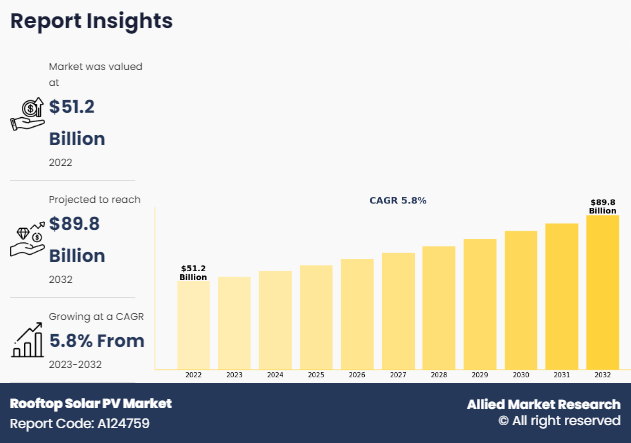
Introduction
Rooftop solar is a type of roof-mounted electrical system that converts solar energy into electricity. Rooftop solar is a distributed power-generating system that helps satisfy a building's energy demand within an existing distribution network, which can be on-grid or off-grid. The size of the installation is determined by the scale of the structure and might vary greatly. Rooftop solar systems are compact and are mounted on the rooftops of residential and commercial buildings.
According to the Solar Energy Industries Association (SEIA), the U.S. government has implemented laws such as net metering and community solar to promote the usage of solar technology to generate electricity. In countries such as the U.S., Spain, France, and others, consumers can utilize solar energy for their own electricity needs and sell the remaining solar power. In addition, community solar refers to local solar facilities shared by multiple community subscribers who receive credit on their electricity bills for their share of the power produced. The China solar cell industry has witnessed significant growth as compared to any other country over the years.
According to the China Photovoltaic Industry Association, China's type of solar energy grew by 14% in 2022 compared to 2021. The total installed PV type surpassed 390 gigawatts at the end of 2022 as compared to 253 gigawatts in 2020.
Key Takeaways
- The rooftop solar PV market is highly fragmented, with several players including Jinko Solar Holding Co. Ltd., JA Solar Holdings Co. Ltd., Trina Solar Co. Ltd., LONGi Group, Canadian Solar Inc, First Solar, Inc., SunPower Corporation, Indosolar Ltd., Hanwha Q-cells, and E-Ton Solar Tech Co., Ltd..
- More than 6,765 product literatures, industry releases, annual reports, and other such documents of major rooftop solar PV industry participants along with authentic industry journals, trade associations' releases, and government websites have been reviewed for generating high-value industry insights.
- The study covers more than 20 countries in terms of value during the forecast period 2022-2032 is covered in the rooftop solar PV market report.
Market Dynamics
India's rooftop solar policies for 2024 highlight a concerted effort towards sustainable energy adoption and economic empowerment. The Interim Budget 2024-25 reiterates the government's commitment to providing free electricity to one crore households through rooftop solar installations, enabling households to receive up to three hundred units of free electricity monthly and sell surplus power back to distribution companies. Additionally, a significant budget allocation of INR 4,555 crore underscores the government's dedication to expanding rooftop solar initiatives. Delhi's Solar Policy 2024, spearheaded by Chief Minister Arvind Kejriwal, offers zero electricity bills for domestic consumers adopting rooftop solar panels and halved tariffs for commercial and industrial consumers. These policies, coupled with initiatives like the National Portal for Rooftop Solar and the Residential Rooftop Solar Program, signify India's determination to unlock the economic and environmental potential of solar energy, promoting clean energy adoption and fostering sustainable development nationwide. These factors collectively are anticipated to drive the rooftop solar PV market growth. The presence of the variables will accelerate the global expansion of the rooftop solar PV market.
High installation costs and the necessity for roof-mounted solar panel maintenance are impeding industry expansion. Furthermore, while solar technology is an excellent choice for a variety of end use applications, the high capital expenditures associated with solar installations when compared to other developing renewable technologies, limit market expansion. The cost of deploying glass will add to the overall cost of solar panels, limiting the overall deployment of PV systems during the forecast period. Furthermore, Solar energy is collected for a specific period and stored in batteries for future use, which are expensive, large, and require regular replacement.
The Paris Agreement signed by the governments of various countries in 2016, aims to increase the ability of the parties to adapt to climate change effects, mobilize sufficient finance, and push each country to determine, plan, and regularly report on its contribution to climate-friendly initiatives to contain global warming. This is prompting developing and developed countries to mobilize funds and support domestic and international environmental initiatives to minimize global carbon emissions. In addition, governments of various countries have taken initiatives to increase the utilization of solar energy through various tax incentives and green subsidies. Such trends and growing demand for clean energy sources are expected to offer growth opportunities for rooftop solar PV market during this forecast period.
The North America region is expected to witness significant growth at a CAGR of 14.8% during the forecast period. The U.S. Government has implemented policies such as net metering and has taken up community solar projects to encourage the usage of solar technology. Such initiatives are expected to offer growth to the market. The U.S. is the second largest energy consumer, after China. The majority of this energy is derived from fossil fuels. Owing to increase in carbon footprint, the U.S. Government has implemented stringent environmental regulations regarding the usage of fossil fuels and is encouraging the use of photovoltaic energy by enforcing policies, such as net metering and taking up community solar projects.
In 2022 and 2023, solar energy experienced substantial growth in the U.S. The U.S. Energy Information Administration (EIA) projected that 45% of electric capacity additions in 2022 would come from solar, totalling 17 GW, and this percentage is expected to rise to 56% in 2023, reaching 31 GW. Remarkably, the U.S. solar industry is set to expand by a record 32 GW in 2023, representing a 52% growth compared to the previous year. The first half of 2023 saw significant photovoltaic (PV) installations, with the U.S. installing 11.2 GW, marking its largest H1 ever. The global trend also revealed increased PV installations in China and Germany. Despite flat or slightly increasing PV system and power purchase agreement prices in the U.S., global module prices reached a record low, highlighting the dynamic landscape of the solar market. This information underscores the pivotal role solar energy plays in the U.S. energy transition, with continued growth anticipated in the coming years.
Segments Overview
The rooftop solar PV market is segmented into deployment, technology, grid type, end use, and region. Depending on the deployment, it is categorized into terrace-mounted and pole-mounted. On the basis of technology, it is bifurcated into thin film and crystalline silicon. On the basis of grid type, it is classified into Off-grid and grid-connected. On the basis of end use, it is categorized into residential, commercial, and industrial. Region-wise, the market is studied across North America, Europe, Asia-Pacific, and LAMEA. Presently, Asia-Pacific accounts for the largest share of the market, followed by Europe, North America, and LAMEA.
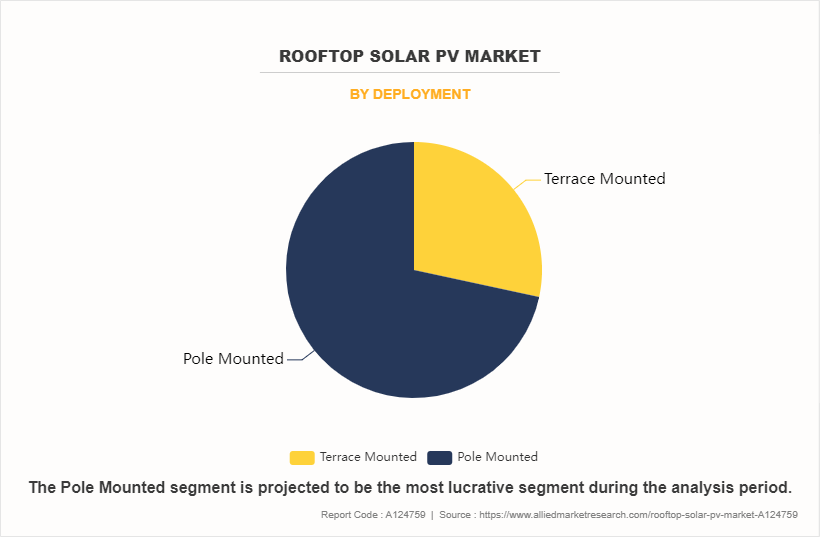
The solar photovoltaic market is majorly contributed by the pole-mounted sector rather than the terrace-mounted segment due to higher installation setups in the pole-mounted deployment applications across the globe. The higher need for utility-scale is anticipated to continue during the forecast period, with strong demand from emerging markets such as China, India, and Brazil.
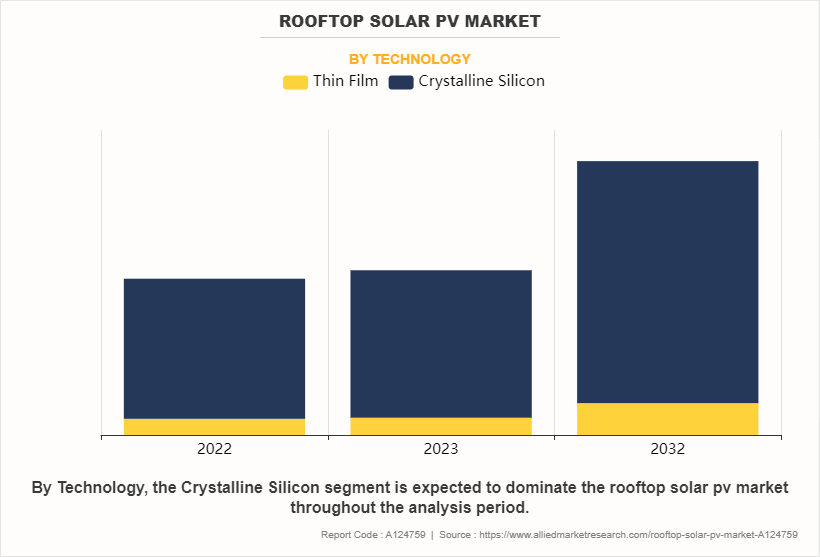
The crystalline segment dominates the global rooftop solar PV market share. Crystalline silicon type solar cells are one of the most widely used semiconductor materials in photovoltaic (PV) technology to manufacture solar cells and are made of highly pure silicon wafers that are further used to convert solar energy into electrical energy. C-Si occupies more than half of the total roof top solar PV market revenue owing to its benefits and improved efficiency. Crystalline silicon solar cells are highly efficient as compared to their rival technologies, for instance, amorphous silicon and non-silicon solar cells. However, high initial investment and reduced efficiency of crystalline silicon at extremely elevated temperatures restrain the market growth. Technological advancements in the field of solar cells to increase efficiency and rise in government spending on renewable energy projects are expected to provide growth opportunities in the rooftop solar PV market forecast period.
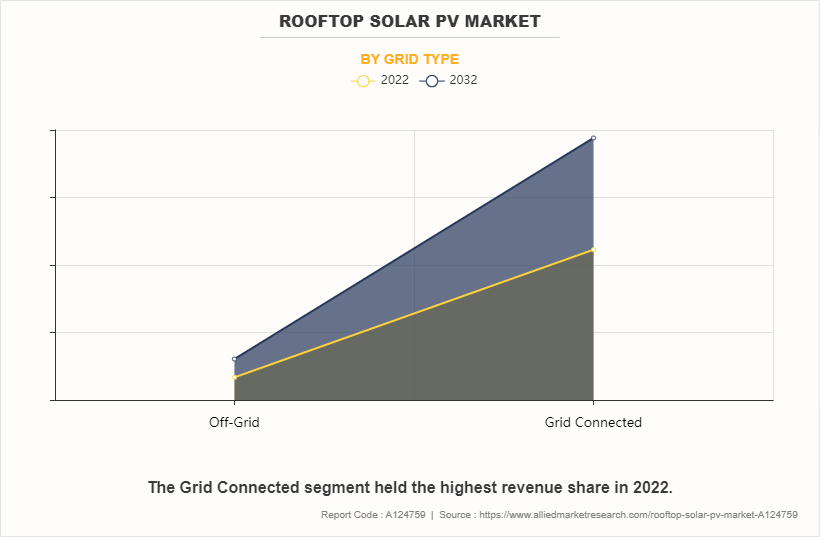
The grid connected segment dominates the global rooftop solar PV market size. Grid connected means that the solar system is connected to the grid of a local utility. Most residential homes will employ this since it protects consumers if their solar system under or over-produces concerning their variable energy needs. The on-grid solar system does not require batteries, it is cheaper to install when compared to an off-grid system. It is less costly when compared to other solar systems. An off-grid solar energy system is not tied to the utility grid but is connected to the local grid facility. Such factors are expected to provide growth opportunities for the development of the market during the forecast period.
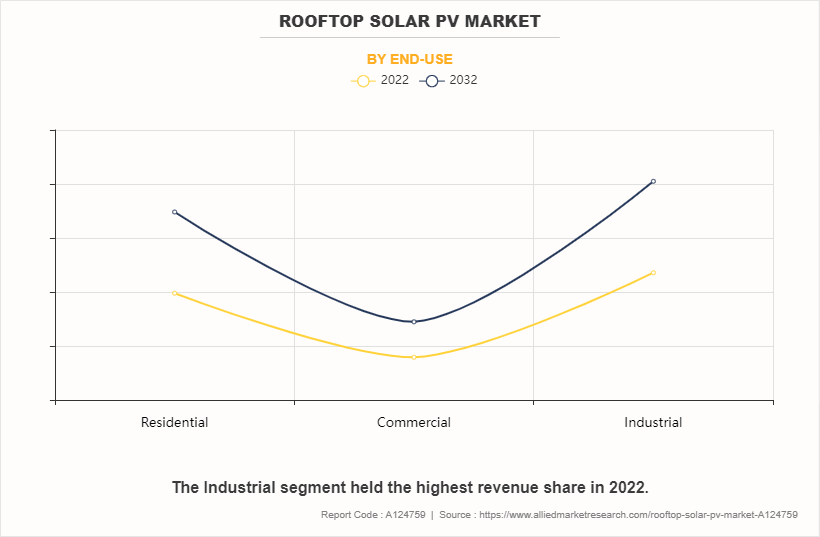
The industrial segment is the dominant segment and witnessed significant growth. The market is driven by the fact that rooftop solar photovoltaic systems are widely utilized for power generation to power various devices during the power outages and can be quickly installed on industrial infrastructure.
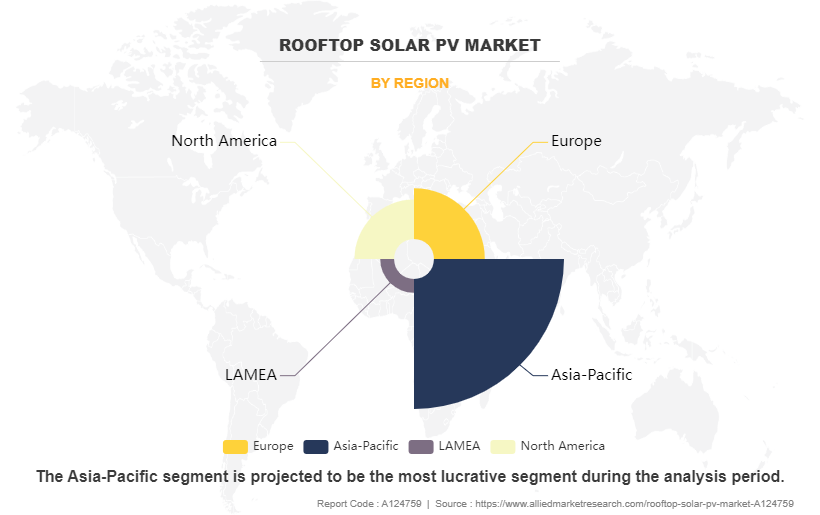
Asia-Pacific segment dominated the global rooftop solar photovoltaic (PV) market. In Asia-Pacific, solar energy is widely used in the generation of electricity for standalone systems and rural electrification. India and China are major players in this region majorly due to their huge population and their energy demand. Solar power is a fast-developing industry as a part of the renewable energy sector in India. Building energy consumption accounts for more than a third of India’s total energy consumption, hence making buildings more energy efficient, and increasing investment of local producers for clean energy has fuelled the demand for flexible solar panels. In China, Zhejiang-based China southeast space frame group, a manufacturer of large-sized steel structures, and EVA a back sheet manufacturer of the first PV have set up a joint venture to develop building integrated PV projects across China. This joint venture is expected to deploy up to 950 MW of BIPV systems over the next five years. The above factors drive the growth of the rooftop solar PV market in this region during this forecast period.
Competitive Analysis
The major companies profiled in this report include Jinko Solar Holding Co. Ltd., JA Solar Holdings Co. Ltd., Trina Solar Co. Ltd., LONGi Group, Canadian Solar Inc, First Solar, Inc., SunPower Corporation, Indosolar Ltd., Hanwha Q-cells, and E-Ton Solar Tech Co., Ltd. The decline in the cost price of solar panels and the increase in awareness among the people regarding the advantages of utilization of rooftop solar panels have a positive impact on the rooftop solar photovoltaic (PV) industry. Additional growth strategies such as an expansion of storage capacities, acquisition, partnership, and research & innovation in the optimization and improvement of the efficiency and reliability of sodium-ion batteries have led to key developments in the global rooftop solar PV market trends.
Recent Trends in rooftop solar PV market
- According to Wood Mackenzie, there has been a 24% growth in rooftop solar PV installations through the first three quarters of 2023. This positive trend indicates an increasing adoption of solar PV systems on rooftops.
- California witnessed a significant surge in rooftop solar installations. Customers were motivated to secure legacy NEM 2.0 rates, driving increased adoption of solar PV systems on rooftops.
- Rooftop solar PV significantly contributes to reducing global carbon emissions. By the end of 2020, installed PV capacity had already saved more than 860 million tons of COâ‚‚, and it is estimated that the gigatonne (Gt) threshold was reached in 2021.
Key Benefits For Stakeholders
- This report provides a quantitative analysis of the rooftop solar PV market overview, segments, current trends, estimations, and dynamics of the rooftop solar pv market analysis from 2022 to 2032 to identify the prevailing rooftop solar pv market opportunities.
- The market research is offered along with information related to key drivers, restraints, and opportunities.
- Porter's five forces analysis highlights the potency of buyers and suppliers to enable stakeholders make profit-oriented business decisions and strengthen their supplier-buyer network.
- In-depth rooftop solar PV market analysis with respective segmentation assists to determine the prevailing market opportunities.
- Major countries in each region are mapped according to their revenue contribution to the global market.
- Market player positioning facilitates benchmarking and provides a clear understanding of the present position of the market players.
- The report includes the analysis of the regional as well as global rooftop solar PV market trends, key players, market segments, application areas, and market growth strategies.
Rooftop Solar PV Market Report Highlights
| Aspects | Details |
| Market Size By 2032 | USD 89.8 billion |
| Growth Rate | CAGR of 5.8% |
| Forecast period | 2022 - 2032 |
| Report Pages | 225 |
| By Deployment |
|
| By Technology |
|
| By Grid Type |
|
| By End-Use |
|
| By Region |
|
| Key Market Players | Canadian Solar Inc., JA Solar Holdings Co. Ltd., SunPower Corporation, First Solar, Inc., Hanwha Q-cells, Jinko Solar Holding Co. Ltd., E-Ton Solar Tech Co., Ltd., LONGi Group, Indosolar Ltd, Trina Solar Co. Ltd. |
Analyst Review
The global rooftop solar PV market is expected to witness increased demand during the forecast period. Increase in investment in solar power generation in residential and commercial buildings has led to rise in demand for rooftop solar services, which positively impacts the market growth.
Solar rooftops are solar panels set on top of roofs of buildings. They capture the sunlight energy emitted by the sun and charge it into electrical energy. This complete system is also called a solar rooftop photo-voltaic system.
The solar panel infrastructure on the rooftops of the building generates a clean and eco-friendly form of energy. These solar panels are installed on the roof of any residential and non-residential building. These systems are connected to the grid or the off grid with a battery system. The abundant availability of solar energy and the presence of solar radiation on buildings through building integrated solar panels and solar rooftops have a significant impact on the market's development. With the above-mentioned factors, the rooftop solar PV market is expected to grow at a significant rate in the forecast period.
The rooftop solar PV market is analyzed across North America, Europe, Asia-Pacific, and LAMEA. Among the analyzed regions, Asia-Pacific is likely to account for the fastest-growing market throughout the forecast period, followed by Europe, North America, and LAMEA. Asia-Pacific region hosts some of the fastest developing countries such as China and India. The presence of a huge population and rapid industrialization in these countries has increased the demand for electricity from renewable resources. The presence of demand for renewable energy in this region and government initiatives and investment to develop infrastructure related to smart cities in this region have led to the presence of significant importance of the rooftop solar PV market.
$89.8 billion is the estimated industry size of Rooftop Solar PV market in 2032.
Cost Reduction, Government Incentives and Policies, Energy Storage Integration, Smart Technology and IoT, Virtual Power Plants (VPPs) and Peer-to-Peer Trading are the upcoming trends of Rooftop Solar PV Market in the world.
Industrial is the leading end-use of Rooftop Solar PV Market in 2022.
Asia-Pacific is the largest regional market for Rooftop Solar PV during the forecast period.
Jinko Solar Holding Co. Ltd., JA Solar Holdings Co. Ltd., Trina Solar Co. Ltd., LONGi Group, Canadian Solar Inc, First Solar, Inc., SunPower Corporation, Indosolar Ltd., Hanwha Q-cells, and E-Ton Solar Tech Co., Ltd are the top companies to hold the market share in Rooftop Solar PV market.
Loading Table Of Content...
Loading Research Methodology...



